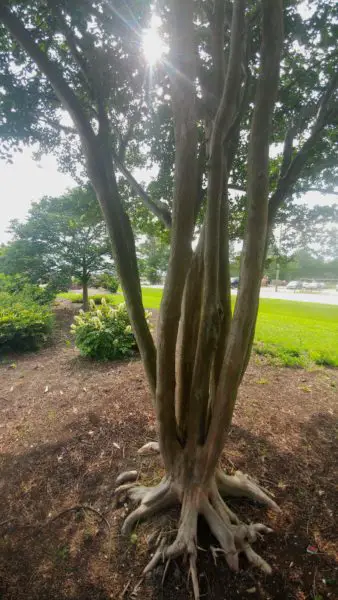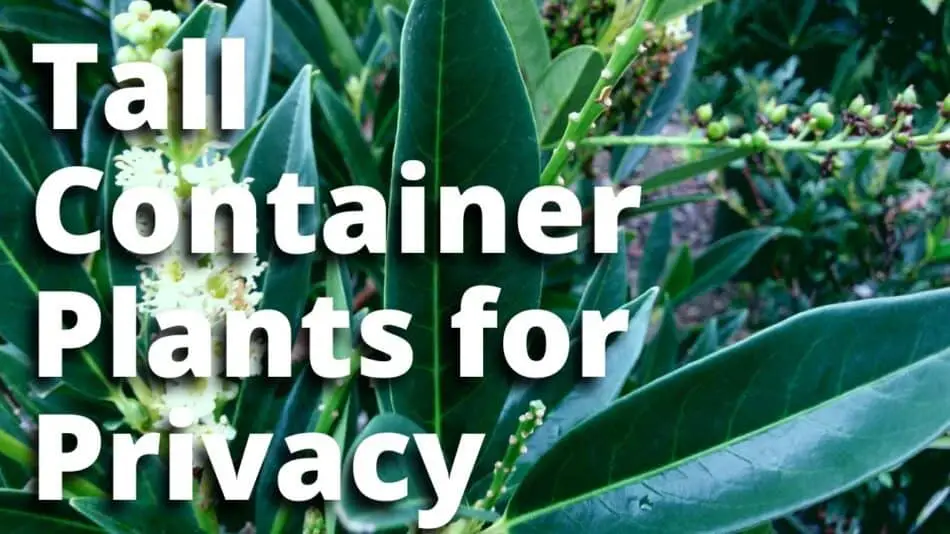Do you have a hedge, whether recently or it is an established planting, and it just does not seem to grow? It seems stunted and stuck at the same size?
When I go out to a client’s home to investigate why the hedges are not growing, this is exactly the process and questions I ask to get to the answer. I start with the most common issues and move down to the more rare, but possible, causes.
“When you hear hoofbeats look for horses, not zebras”
-Folk Wisdom
Are The Watering Levels Right For This Plant?
There are two watering levels that commonly cause reduced growth in plants:
-Not enough water:
Hedges can take a lot of water. You plant a lot of plants in a small space. They will compete with each other for resources including water. For a new hedge, remember that those plants were watered daily if not more, in their pots. There is a lot of foliage for a small root system to support. The particular plant you choose to make your hedge from might be drought resistant, but that will only happen after it has become established. The roots need to grow to a size that can support the entire plant.
At Planting- water deeply (until the water reaches down as deep as the lower levels your potted plant’s roots are). Check daily, if you feel no moisture a few inches down, water deeply again. The exact volume of water to use will vary depending on your soil, and the size of your plant.
To read more about that, click here to read Watering newly planted trees and shrubs | UMN Extension
–Too much water:
Waterlogged soils are soils that stay wet for more than 24-48 hours after rain, to soils that stay boggy due to excess water coming into the soil.
Most nursery plants do not thrive in waterlogged soils. You will need to grow those specific varieties that do, improve drainage, change the location of your plants, or put them in a raised bed.
Is There Aminal Damage to the Plant?
-peeing on, neighborhood dogs, cats, or even wildlife.
-physical rubbing/ tearing. Wildlife, such as deer, can do a lot of damage by rubbing new antlers on trees and shrubs. Local pets can become enamored with the smell of your plant and continually rub against it.
-eating/ browsing
Green growth/buds
- Deer
- Roots
- Grubs
- Moles
- Mice
- Bark
- Rabbits
- Deer
- Mice
Is There Mechanical Damage To This Plant?
The most common causes of mechanical damage are:
- -weed trimmer / mower
- -root damage when transplanting
- -digging near plant
- -vehicle backed / driven over
To see more about string trimmer damage, click here to see a short YouTube video showing you some damage and a few ways to prevent – string trimmer damage
How Long Has This Plant Been Growing Here, Is It Established Yet?
A plant is established when the roots have grown to support the top growth of the plant as if it had been grown there from the start. The younger the plant, the faster it can become established.
Many plants will pause their upward green growth to focus their energy on their root growth the first year or 2 after planting. Chindo Viburnum for example is an example of a very fast-growing shrub, a great evergreen hedge shrub for warm areas, that will look stalled in growth for a season or two, and then stand back as it takes off! It was just putting down the root system the plant needs to support that fast growth.
What Are The Soil Conditions?
Many people think soil is just dirt that holds the plant roots so the plant doesn’t blow away. There is so much more than that. A green thumb is 90% good soil. If your hedge plants are not growing, look to your soil. Does it have these challenges:
-compacted from animal/ people/ vehicle traffic
-not a good plant/soil match
-how much soil to grow in? Between paved areas?
-near the walkway, salt in winter?
If there are any of these challenges..amend the soil. Good compost will go a long way. Then mulch.
(Pro tip – next time, do this first….)
Beside The front Door
“Salinity and sodicity are soil conditions that occur mainly in arid and semiarid regions. Rainfall leaches salts out of soils in humid regions, and salt problems are rare and transitory.” https://www.semanticscholar.org/author/L.-Bernstein/145024831
If the problem is not watering, animal or mechanical damage, or the soil, then I dig deeper:
Is The Type of Plant Proper For Growing Conditions?
Under Overhang/gutter/roof edge?
Planting under the overhang prevents the plants from getting the water they need, plus often the soil is backfilled with who knows what construction debris..both of the top two stunted growth culprits rolled into one.
Or, is the plant in the drip line, so all the rain, and snow, coming off the roof pounds right down on it? All of that concentrated water holds great force, and erodes the soil away from the plant roots as well as just physically beats down on the plant every time it rains.
Weed competition
If your space was not cleared of weeds and mulched well after planting, the plants native to that soil may just be outcompeting your transplanted hedge. Taking all the water, and nutrients. Control the weeds, at least until your hedge is established and can compete for these resources on its own.
Wind Stress
Wind will suck an enormous amount of precious moisture from the leaves of your chosen hedge, all the while it is trying to use that moisture to grow new roots and new foliage. In the industry, we know that during a windy day, we might need to water even twice as much as a calm day. If the wind is a constraint battle in your area, erect a windscreen to slow that wind down to give a fighting chance to your hedge. After it has been established, a well-chosen hedge planting will be able to fend for itself from the drying effects of the wind.
Heat Stress
Insect infestation
Examine the leaves carefully. Are there obvious holes with smooth edges? Is there less obvious tiny stippling of tiny dotted off-color areas giving the leaves an off-shade? Flip the leaves over and examine closely near the ribs of the leaves. This is insects pest’s favorite place to hide.
Is it a dwarf variety, either intentionally (final height the desired size, or a mislabelling at some point from the nurseries?
These dwarf varieties grow much slower than their full-sized counterparts. Often dwarf-sized varieties have smaller leaves, in proportion to their smaller mature size, which can be difficult to ascertain in a young plant in the nursery, but easier to see planted in the garden with some time for full growth to start.
This may be a rare natural mutation, expressing itself as a dwarf plant. This can be propagated to see if it is environmental or a true genetic mutation, if it is a desirable trait, it might even deserve a plant patent. But this would not happen to an entire hedge. One plant in the hedge, or more likely, one branch on one plant in your hedge.
Planted too deep/ planted too shallow.
When planting or transplanting a perennial, annual, tree, or shrub be watchful of the depth the plant ends up at. Too deep and the roots will not get enough oxygen, to shallow and the roots will dry out and may be exposed to too much ultraviolet radiation from the sun. Most vines are not as picky.

Trees are the easiest to see the correct depth, there is a flare at the base of every trunk, where the straight sides widen out to the root mass. The tree is planted so the flare is visible above the ground, while the roots are under the ground. Mulch is placed over the soil covering the roots, but not touching the trunk or over the flare. The mulch will be a ring, like a doughnut or a bagel, not touching the trunk. No mulch volcanoes!

Viral/Bacterial/fungal disease
Diseases can stunt plants’ growth, and some can kill the plant. There are volumes of books filled with specifics about a multitude of diseases that affect plants. Some of the most common will show themselves as growths on the plants, mainly leaves. Films over the leaves, spotting of different colors that turn brown and fall out leaving holes, strange mutated growth, or pigmentation. If a plant is growing in a manner not expected, and insects, soil fertility, and physical stressors are ruled out, suspect a disease. This is time to contact your local expert or extension agent to come to look at your plant to determine if it can be saved.
Nutrient imbalance
A lot of attention is given to nutrient shortages, where fertilizer can be applied to correct an imbalance, but too much of a nutrient is just as stressful, and not as easy to correct as a lack of nutrient. Overzealous fertilization can through the nutrient balance off, making some nutrients in the soil unavailable due to the excess of another nutrient. If you have been very free with the fertilizers, and suspect a nutrient shortage, get a complete soil test done by your local extension agent, not just an NPK test, but one that tests pH, magnesium, iron, etc. You need to know what is off and if an excess of one nutrient is causing the shortage of another.
If the hedge has been there for the 2nd year or more after planting, then I investigate these causes:
- Water stress
- Cold stress
- any of the above causes
- History of the area? Contamination? Heavy metals?
Sources:





